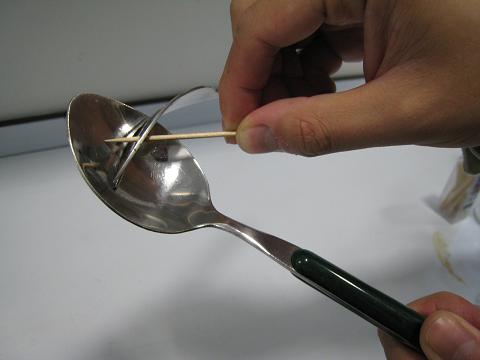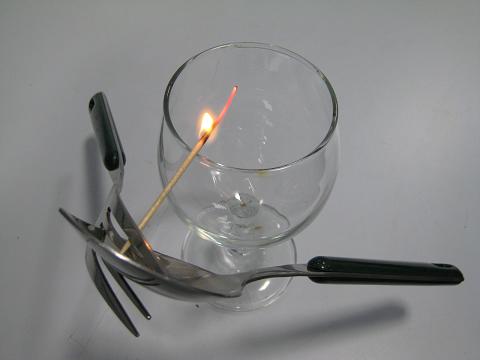Centre of mass of a body in a horizontal plane
This demonstration shows how to locate the centre of mass of a horizontal L shaped body.






Figure 2-2b shows an L-shaped area whose centre of mass C is outside the body. The following simple experiment, using a fork, a spoon, a toothpick and a wine glass, can be carried out to locate the centre of mass of an L shaped body made up from a spoon and fork.
- Take a spoon and a fork and insert the spoon into the prongs of the fork, to form an L-shape as shown in Fig. 2-7a.
- Then take a toothpick and wedge the toothpick between two prongs of the fork and rest the head of the toothpick on the spoon as shown in Fig. 2-7b. Make sure the end of the toothpick is firmly in contact with the spoon.
- The spoon-fork can then be lifted using the toothpick. The toothpick is subjected to an upward force from the spoon, a downward force from the prong of the fork and forces at the point at which it is lifted as shown in Fig. 2-7c.
- Place the toothpick on to the edge of a wine glass adjusting its position until the spoon-fork-toothpick is balanced at the edge of the glass as shown in Fig. 2-7d. According to the definition of the centre of mass, the contact point between the edge of the glass and the toothpick is the centre of mass of the spoon-fork-toothpick system. The mass of the toothpick is negligible in comparison to that of the spoon-fork, so the contact point can be considered to be the centre of mass of the L-shaped spoon-fork system.
- To reinforce the demonstration, set alight the free end of the toothpick (Fig. 2-7e). The flame goes out when it reaches the edge of the glass as the glass absorbs heat. As shown in Fig. 2-7f, the spoon-fork just balances on the edge of the glass.
If the spoon and fork are made using the same material, the centre of mass and the centroid of the spoon-fork system will coincide.
